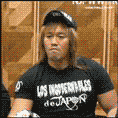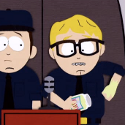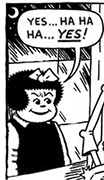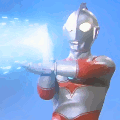|
Because when someone says "gridless" I assume TOTM. Running mass combat with 10+ combatants can happen a lot in 4e and that would get messy in TOTM. If you're talking still using miniatures on a tabletop and measuring out movement and stuff then that can sort of work I guess. I'm not sure how Blasts would work since those aren't really supposed to be cones.
|
|
|
|

|
| # ? May 30, 2024 08:40 |
|
Kurieg posted:Because when someone says "gridless" I assume TOTM. Everything you say about TOTM getting messy applies equally to prior editions. That's my point. How do you judge where the 3.X Wizard's spell lands in TOTM? How do you handle a big epic battle with a kraken and its tentacles on a shifting ice flow? If you have an answer to these that applies to 3.X or Next then why doesn't it apply equally to 4E? What's the mystery factor preventing you from running 4E gridless?
|
|
|
|
Kurieg posted:Because when someone says "gridless" I assume TOTM. As an aside, this is a bad assumption, off the top of my head, FATE, 13th age, and Old School Hack (oh, and original Traveller) all use zone based combat systems.
|
|
|
|
Kai Tave posted:Everything you say about TOTM getting messy applies equally to prior editions. That's my point. How do you judge where the 3.X Wizard's spell lands in TOTM? How do you handle a big epic battle with a kraken and its tentacles on a shifting ice flow? I've run 3.5 TOTM once, when we only had two players and the caster used almost nothing but single target spells. As far as gridless? I don't know, I've never been in a situation to play 4e or even 3.5 where a grid wasn't readily available. Both of my RL gaming groups had one. I imagine you could do it but like I said, bursts and blasts would need to be reconfigured a bit, since they're squares and not circles. Like I said, my argument was mostly against a TOTM thing, Gridless wouldn't be ideal but it would be possible. DalaranJ posted:As an aside, this is a bad assumption, off the top of my head, FATE, 13th age, and Old School Hack (oh, and original Traveller) all use zone based combat systems. But those were designed with TOTM in mind and they handle it quite well as a result.
|
|
|
|
From my observations, anyone who clamors for D&D to be able to be run gridless/TotM doesn't care if it actually works, they just want to be told that it works so that they can nod approvingly, check it off the Real D&D Checklist, and resume running it gridded anyway.
|
|
|
|
Kurieg posted:But those were designed with TOTM in mind and they handle it quite well as a result. What? My point was that zone-based is explicitly not theatre of the mind. VV Yes, That's why it was an aside. DalaranJ fucked around with this message at 22:41 on May 3, 2015 |
|
|
|
Yes but we're not talking about them, we're talking about DnD. If someone's talking about running "Gridless 4e" it's a fairly safe assumption that they aren't talking about FATE's zone system.
|
|
|
|
DalaranJ posted:What? My point was that zone-based is explicitly not theatre of the mind. Sorry, what? I don't understand this point at all, but maybe I'm just dense today. Why does the use of zones preclude TOTM? Doesn't the use of zones make positioning easier to track in your head?
|
|
|
|
Mendrian posted:Consider the Bone Zone example. When confronted with the Bone Zone many 5e apologists claim that a good DM would never let a Wizard 'get away' with that despite it being a pretty simple interpretation of the rules. A good DM is one who will look a player in the eye and say "Dammit, [PLAYER], you'll never get away with this." A good player is one who will laugh and say "Oh, but I already have."
|
|
|
|
CaptCommy posted:Sorry, what? I don't understand this point at all, but maybe I'm just dense today. Why does the use of zones preclude TOTM? Doesn't the use of zones make positioning easier to track in your head? Let me reword this then. Kerieg said "To me, gridless means TOTM". However, TOTM means without miniatures. I responded by pointing out a set of games where the rules set suggests play with miniatures but without a grid. I did not mean to convey that if you are playing a game with zone based combat it cannot be converted to TOTM. It is, of course, much easier to do so then with a rules set that suggests grided play, and one of the reasons is the one you stated.
|
|
|
|
thespaceinvader posted:The fundamental issues are, then, IMO: On the other hand, FATE and SW:EotE are actually designed to be easy to ToTM combat. In FATE a slow character would be represented as such using the existing aspect/FATE point mechanics, which have extensive mechanical support and GM advice. In SW:EotE slow characters are designated as such by limiting how many movement maneuvers they can take per combat, which is extremely easy to adjudicate given how the rest of the combat system works, and will have a major impact on battle strategies. If the designers of 5E had actually been serious about TotM combat they'd have actually put some thought into how movement speeds and TotM interact, then either replaced the existing positioning system or (somehow) worked it over to actually serve TotM combat instead of just copy-pasting the system from every other edition and calling it a day. Splicer fucked around with this message at 01:26 on May 4, 2015 |
|
|
|
Kurieg posted:I've run 3.5 TOTM once, when we only had two players and the caster used almost nothing but single target spells. So 3.X works in "theater of the mind" so long as you strenuously avoid engaging with the combat system in any but the most basic sense, got it. Look I'll just drop the rhetorical question angle...there is no functional difference between running 3.X gridless/TOTM/whatever we're calling it and doing the same with 4E. It's all meant to be played on a grid, it's full of stuff divided into 5-foot increment measurements, it's full of area-effect stuff and things that are more or less envisioned from a gridded perspective first and yet for some reason people are insistent that none of this matters to 3.X or Next but as soon as 4E comes around it's like a gun is suddenly held to their heads and it's just not possible to run it without miniatures and any attempts to the contrary are doomed to failure. Like this: quote:As far as gridless? I don't know, I've never been in a situation to play 4e or even 3.5 where a grid wasn't readily available. Both of my RL gaming groups had one. I imagine you could do it but like I said, bursts and blasts would need to be reconfigured a bit, since they're squares and not circles. Squares versus circles? Who cares? How does the abstract shape of an imaginary fireball matter if you're just handwaving things. Did Bob's fireball hit those goblins and not your teammates? Ask your GM. Now quick, which edition did I pull that example of gridless adjudication from? Answer: all of them, if you're playing D&D "theater of the mind" style. 4E is no less feasible to run this way, and anyone who claims otherwise is flat-out wrong.
|
|
|
|
To elaborate on the 'good DM hypothesis a bit after some dinner: There's this notion that a good DM can compensate for a bad system. You know, it doesn't matter if the Wizard is better than the Fighter or if one character has objectively The Best stats or if one character busts the game wide open with an item you accidentally rolled on an random item chart - a good DM can reign in those players and make sure the other players get screen time and relevancy. Assuming anybody is capable of doing that, imagine how much better that guy would be if he wasn't doing all that poo poo. A master archer can compensate for wind and noise and distraction and all kinds of other poo poo but I'm going to guess that it's much easier to hit a moving target under optimal conditions than it is under sub-optimal ones. Also any system that requires you to fight against the enjoyment of your players when all they're really doing is playing the game is pretty stupid. I don't really know how that makes you a 'good' DM. EDIT: Kai Tave posted:So 3.X works in "theater of the mind" so long as you strenuously avoid engaging with the combat system in any but the most basic sense, got it. I think a lot of it stems from the fact that 4e decided to describe its distances in terms of squares. Which if you think about is eminently more useable than feet but the fact remains that 3.X described everything in discrete distances. I don't know why people are enamored of this - they must know that 5 feet = 1 square in their head somewhere and question why literally everything in the universe translates into precise 5 foot increments but here we are. I think the big thing though is that 4e is a joy to play at the table and for the most part when you remove the grid it's no longer fun. 3.x is a game that is not really enhanced by a grid, it's just made legible. Mendrian fucked around with this message at 02:25 on May 4, 2015 |
|
|
|
If we're talking about Theater of the Mind in terms of "the grid is still there, you just don't represent it visually and track everything in your head like security guards playing chess over a walkie talkie", then yes, it's technically possible to play 3.5e, 4e, and 5e like that, but I don't know how much time you'd really be saving doing it like that because even single square distances need to be tracked. If we're talking about Theater of the Mind as far as ditching the whole grid entirely, 5e's rules-as-written does not support that.
|
|
|
|
Mendrian posted:I think a lot of it stems from the fact that 4e decided to describe its distances in terms of squares. Which if you think about is eminently more useable than feet but the fact remains that 3.X described everything in discrete distances. I don't know why people are enamored of this - they must know that 5 feet = 1 square in their head somewhere and question why literally everything in the universe translates into precise 5 foot increments but here we are. The thing is that I'm certain that somewhere in the annals of 3rd edition Dungeons & Dragons there must be some class feature, spell, or special ability that knocks a target backwards some distance. So what happens whenever a player in one of these many 3.X freeform games I hear so much about uses one of those? Does the game just lock up and become unplayable? Does everyone run screaming into the night clawing at their flesh? Does the GM just slowly fold his screen up and sit there in stony silence, giving you a look of stern disapproval? It's not that I disagree that 4E is enjoyable to play on a grid with figures, but if you absolutely must play D&D without bringing a map into the equation I fail to see how it presents any real obstacle to that which previous editions didn't. If the distance an orc gets knocked back or the area a fireball covers are important enough to you to merit more than a cursory handwave before getting back to business then why are you playing either edition without a map?
|
|
|
|
Kai Tave posted:The thing is that I'm certain that somewhere in the annals of 3rd edition Dungeons & Dragons there must be some class feature, spell, or special ability that knocks a target backwards some distance. EDIT: Bull rush.
|
|
|
|
Kai Tave posted:The thing is that I'm certain that somewhere in the annals of 3rd edition Dungeons & Dragons there must be some class feature, spell, or special ability that knocks a target backwards some distance. http://www.d20srd.org/srd/monsterFeats.htm quote:Awesome Blow [General, Fighter] Complete Warrior, page 135 quote:Knockback: Knockback weapons often emit a low, almost inaudible hum when drawn. Whenever a knockback weapon hits its target, it initiates a bull rush attack in addition to dealing normal damage. To resolve the bull rush attempt, treat the projectile as a Medium creature with a +8 Strength bonus. The projectile doesnít provoke an attack of opportunity, and it always tries to push the target as far back as possible. Only ranged weapons can have the knockback ability, and they bestow it on their ammunition. Races of Stone, page 142 quote:KNOCKBACK [GENERAL]
|
|
|
|
Woah poo poo, you can knock somebody back ten whole feet if you have, like, 25 Strength and happen to be size Large. Ten feet! Is there an adjective beyond "epic?" That 1d6 damage might be a bit too much though.
|
|
|
|
What did you expect it to do, knock them into another dimension and vaporize them? It's not magic, you idiot.
|
|
|
|
It would be pretty cool if instead of theatre of the mind, there was something along the lines of the combat in darkest dungeon. That's a lot easier to keep track of than positional maps. And the rules could be modified to support it without much trouble, at all.
|
|
|
|
friendlyfire posted:It would be pretty cool if instead of theatre of the mind, there was something along the lines of the combat in darkest dungeon. That's a lot easier to keep track of than positional maps. And the rules could be modified to support it without much trouble, at all. Yeah definitely. In fact I just go and play systems that work like that anyway.
|
|
|
|
friendlyfire posted:It would be pretty cool if instead of theatre of the mind, there was something along the lines of the combat in darkest dungeon. That's a lot easier to keep track of than positional maps. And the rules could be modified to support it without much trouble, at all. How does it work there? I keep meaning to get Darkest Dungeon but other sales keep getting in the way.
|
|
|
|
It has always seemed kind of weird to me that RPGs tend to fall into two categories, either games that assume gridded tactical play (even if they pretend otherwise, but when you measure everything in 5' increments you aren't fooling anyone) and pure "theater of the mind" games where combat is hazy and nebulous. Games that use abstract but nonetheless defined positional combat are fairly uncommon and a huge untapped design space.
|
|
|
|
gradenko_2000 posted:How does it work there? I keep meaning to get Darkest Dungeon but other sales keep getting in the way. Position is party order. Melee attacks can only be used by the front two people, most ranged attacks and support abilities cannot be used from the front (and you wouldn't want to). If you knock a monster back or pull it forward, it is relative to the other monsters. You can completely neutralize a melee monster by knocking it to the back. And there are abilities that pull the vulnerable ranged casters to the front so you can wail on them. It's a great game, I recommend it. kingcom posted:Yeah definitely. In fact I just go and play systems that work like that anyway. Really? Like what?
|
|
|
|
I think it derives from the gridded games taking cues from D&D and/or other boardgames and wargames, while the non-gridded games have far less of a combat focus (and maybe a dash of "anyone who's had better ideas is in other industries"). The genre is still learning from Fate.friendlyfire posted:Position is party order. Melee attacks can only be used by the front two people, most ranged attacks and support abilities cannot be used from the front (and you wouldn't want to). If you knock a monster back or pull it forward, it is relative to the other monsters. You can completely neutralize a melee monster by knocking it to the back. And there are abilities that pull the vulnerable ranged casters to the front so you can wail on them. It's a great game, I recommend it. That's rather brilliant! Reminds me of JRPGs and the Disciples series. gradenko_2000 fucked around with this message at 05:55 on May 4, 2015 |
|
|
|
Theatre of the mind was OK for play in the earliest editions when played in the groggiest way possible. Form up your team three by three and dungeon crawl a couple of old school maps with ten feet wide corridors where encounters are rarely more distantly met than a torch light's view away. For a good visual example, play Wizardry or Might and Magic. Not particularly engaging, but functional. Here are some rules for Dungeon adventuring from the Original game: "THE MOVE/TURN IN THE UNDERWORLD: In the underworld all distances are in feet, so wherever distances are given in inches convert them to tens of feet. Movement (distances given in Vol. 1) is in segments of approximately ten min- utes. Thus it takes ten minutes to move about two moves ó 120 feet for a fully- armored character. Two moves constitute a turn, except in flight/pursuit situa- tions where the moves/turn will be doubled (and no mapping allowed). Time must be taken to rest, so one turn every hour must be spent motionless, and double the rest period must be taken after a flight/pursuit takes place. Time spent searching for anything (secret passages, hidden treasure, etc.), load- ing treasure, listening, ESP'ing, hiding, will be adjudged by the referee as to what portion of a turn will be used by the activity. Typically, ESP'ing will take but a quarter turn, while searching a ten foot section of wall for secret passages will re- quire a full turn. Melee is fast and furious. There are ten rounds of combat per turn. Secret passages will be located on the roll of a 1 or a 2 (on a six-sided die) by men, dwarves or hobbits. Elves will be able to locate them on a roll of 1-4. At the re- feree's option, Elves may be allowed the chance to sense any secret door they pass, a 1 or a 2 indicating that they become aware that something is there. Generally, doors will not open by turning the handle or by a push. Doors must be forced open by strength, a roll or a 1 or 2 indicating the door opens, although smaller and lighter characters may be required to roll a 1 to open doors. There can be up to three characters attempting to force open a door, but this will dis- allow them rapid reaction to anything awaiting them on the other side. Most doors will automatically close, despite the difficulty in opening them. Doors will automatically open for monsters, unless they are held shut against them by charac- ters. Doors can be wedged open by means of spikes, but there is a one-third chance (die 5-6) that the spike will slip and the door will shut. Traps are usually sprung by a roll or a 1 or a 2 when any character passes over or by them. Pits will open in the same manner. When characters come to a door they may "listen" to detect any sound within. Note "Undead" never made any sound. A roll of 1 for humans, and 1 or 2 for Elves, Dwarves, or Hobbits will detect sound within if there is any to be heard. A good referee will have noise corridors (moaning, clanking, etc.) and rooms from whence come shuffling or muttering sounds. In the underworld some light source or an infravision spell must be used. Torches, lanterns and magic swords will illuminate the way, but they also allow monsters to "see" the users so that monsters will never be surprised unless coming through a door. Also, torches can be blown out by a strong gust of wind. Monsters are as- sumed to have permanent infravision as long as they are not serving some character. While some referees allow Fire Balls and Lightning Bolts to be hurled in confined spaces, blasting sections of the stone equal to the remainder of their normal shape, it is suggested that the confined space cause these missiles to rebound toward the sender, i.e. a Lightning bolt thrown down a corridor 40 feet long will rebound so as to reach its stated length of 6" (60 feet underground), and this will mean the sender is struck by his own missile. It may also be compromised, allowing say two feet of stone wall to be destroyed (allowing one foot of stone destroyed for every ten feet the space is short of full distance) and rebounding the missile one- half the distance short."(OD&D, Gygax and Arneson)
|
|
|
|
friendlyfire posted:Really? Like what? A lot of games from 13th Age to Star Wars: Edge of the Empire dont have distances and instead just have engagement ranges. You are either at Long, Medium, Close. To make sure both an all melee party and all ranged party are not prevented from playing, they stop the restriction on attacks positions but otherwise people will move and attack each other in a line from Closest to Longest since its easier to hit stuff closer.
|
|
|
|
Kai Tave posted:It has always seemed kind of weird to me that RPGs tend to fall into two categories, either games that assume gridded tactical play (even if they pretend otherwise, but when you measure everything in 5' increments you aren't fooling anyone) and pure "theater of the mind" games where combat is hazy and nebulous. Games that use abstract but nonetheless defined positional combat are fairly uncommon and a huge untapped design space. I did something like this in the heartbreaker I was working on, but designing games is hard and playing them is more fun (even if it is just 5e)
|
|
|
|
Kai Tave posted:It has always seemed kind of weird to me that RPGs tend to fall into two categories, either games that assume gridded tactical play (even if they pretend otherwise, but when you measure everything in 5' increments you aren't fooling anyone) and pure "theater of the mind" games where combat is hazy and nebulous. Games that use abstract but nonetheless defined positional combat are fairly uncommon and a huge untapped design space. I'm seeing a lot more games that do this recently though. The only one I can think of from before 4th edition came out is Traveler. Whether that's just that my view of the variety of RPGs has expanded recently or not, I can't say though.
|
|
|
|
I mean, there are games that do it to be sure, it just seems like it's the "weird indie RPG" option whereas plenty of "bigger name" RPGs just give you a bunch of weapon stats and rules and expect you to just keep track of everything in your head I guess.
|
|
|
|
My retroclone (TAAC) took the approach of "you're either in melee, or you're not"; anyone in melee could attack anyone else in it, and if you weren't in melee you could be forced into it, whereupon trying to withdraw could draw OAs. (I always pictured it as one of those whirling cartoon dustclouds with fists and feet popping out, rolling around the battlefield like a katamari to sweep people up.) That's about as much tactical combat as I can be bothered to endure without a computer to crunch all the numbers.
|
|
|
|
Payndz posted:My retroclone (TAAC) took the approach of "you're either in melee, or you're not"; anyone in melee could attack anyone else in it, and if you weren't in melee you could be forced into it, whereupon trying to withdraw could draw OAs. (I always pictured it as one of those whirling cartoon dustclouds with fists and feet popping out, rolling around the battlefield like a katamari to sweep people up.) That's about as much tactical combat as I can be bothered to endure without a computer to crunch all the numbers. This is great, and as a bit of conjecture I'd take it as far as "If you hit one person in the melee with an AoE, you hit all the people in the melee."
|
|
|
|
Kai Tave posted:I mean, there are games that do it to be sure, it just seems like it's the "weird indie RPG" option whereas plenty of "bigger name" RPGs just give you a bunch of weapon stats and rules and expect you to just keep track of everything in your head I guess. Doesn't WFRP 3e do this? There's basically a straight line of Really far ---- Far ---- Near ---- In Melee --- Near --- Far ---- Really far and you can be in any of those zones. Double Cross does a different abstracted, yet strict, zone system where two or more people in a melee fight are considered to be in an Engagement. It takes an entire turn to Disengage out of an Engagement, and there are abilities which can lock down an Engagement to prevent any movement in or out. Ranged weapons can fire in, or fire out from Engagement to Engagement unless abilities say otherwise. AoEs are usually either the entirety of an Engagement or the entire Scene. People who are Stealthed are free to enter or leave Engagements unless abilities say otherwise. Anyone outside an Engagement is in a sort of nebulous "nearby" space, although there are some rules for determining just how far away from each other those people are if it's really important, like a chase or something.
|
|
|
|
New Unearthed Arcana. http://dnd.wizards.com/articles/features/unearthed-arcana-waterborne-adventures The Mariner Fighting Style is actually pretty great. So great almost everyone should take it unless they are heavily armored. Swashbuckler is a Rogue thing. They can draw aggro. As an action. At 9th. Oh and minotaurs get a free 1d10 weapon.
|
|
|
|
dwarf74 posted:New Unearthed Arcana. A free 1d10 weapon that can be used at the end of the Dash action i.e. a Charge Attack, even. Then again, looking at it, with the way its score increase works, I'd just assume make a variant human with the charge feat and a maul or something.
|
|
|
|
That rogue archetype is pretty bad. A little buff to initiative and sneak attack, 1/3 of the mobile feat, a single target aggro without having any defensive boosts (though the non-hostile usage looks nice), an in-combat skill boost, and a once-per rest reroll with advantage at level 17.
|
|
|
|
So who wants to be the first to fake grogpost in enworld about how Panache is a video game taunt and is an example of disassociated mechanics.
|
|
|
|
gradenko_2000 posted:So who wants to be the first to fake grogpost in enworld about how Panache is a video game taunt and is an example of disassociated mechanics.  (And someone over there already called it a Dominate.) (And someone over there already called it a Dominate.) As for weak... I dunno, the 3rd level swashbuckler can pretty much always get Advantage in melee... The panache bit is a little too expensive action-wise, and the rogue is probably quite squishy.
|
|
|
|
gradenko_2000 posted:So who wants to be the first to fake grogpost in enworld about how Panache is a video game taunt and is an example of disassociated mechanics. At what level does Charm Person come up first?
|
|
|
|

|
| # ? May 30, 2024 08:40 |
|
Man they are allergic to making actual D&D 5e style race stat adjustments for these Unearthed Arcana races. Except Human the stuff in the PHB tends toward +2 to one stat and +1 to another, with a few exceptions that get better than that. But it seems like pretty much all of these Unearthed Arcana races get +1 to two stats. Also Mariner is pretty awesome, and actually a Fighting Style that is useful for classes like Monk and Druid should the character Multiclass.
|
|
|




























